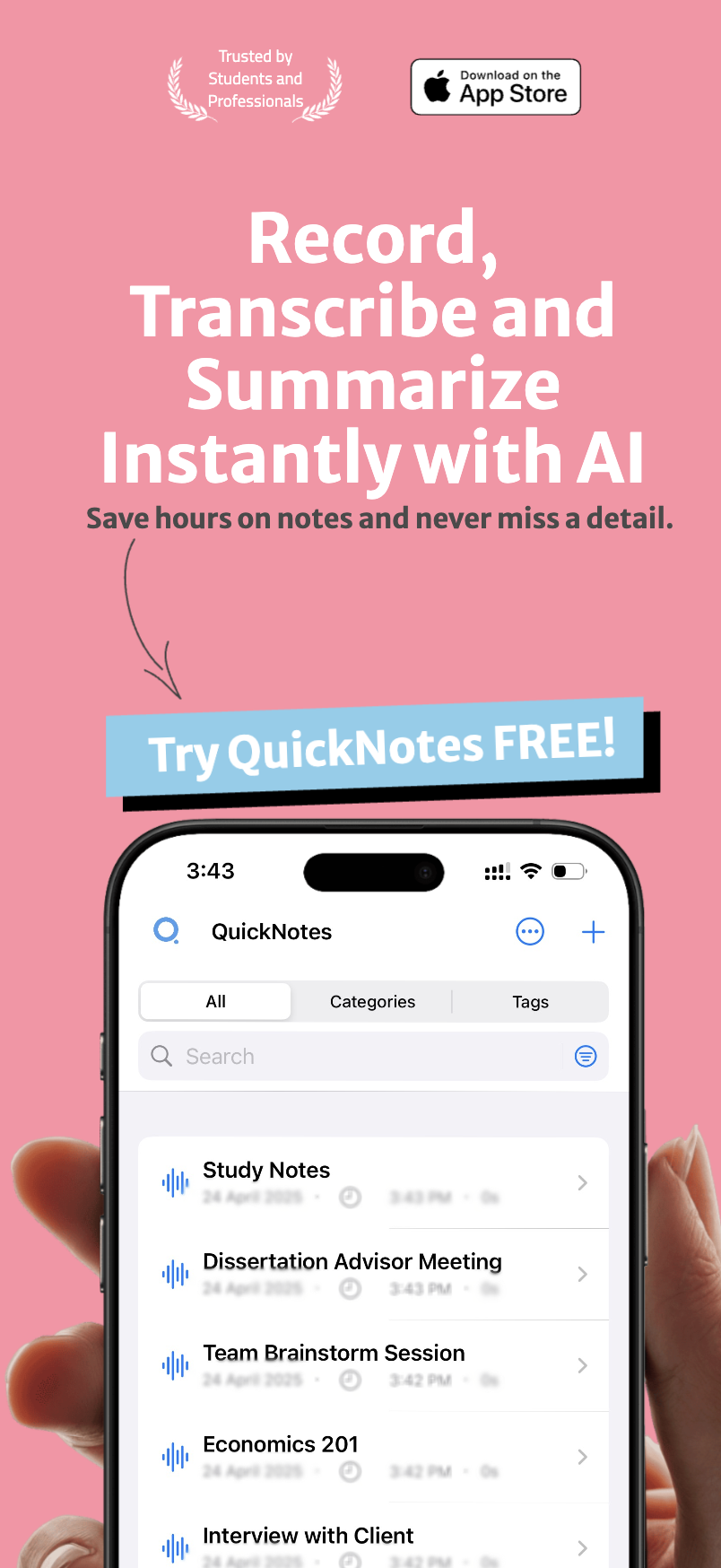Have you ever noticed that you remember information better when you create it yourself rather than simply reading or hearing it? This phenomenon has a name: the generation effect. It's one of the most powerful and well-researched principles in cognitive psychology, showing that people remember information better when they actively generate it rather than passively consume it.
Table of Contents
- Understanding the Generation Effect: The Power of Self-Creation
- The Science Behind the Generation Effect
- Generation Effect in Action: Practical Applications
- 1. Create Rather Than Copy Notes
- 2. Practice Retrieval Through Generation
- 3. Complete Partial Information
- 4. Teach and Explain to Others
- How QuickNotes Enhances the Generation Effect
- 1. Record, Transcribe, and Regenerate
- 2. AI Summaries as Generation Prompts
- 3. Organization as Generation
- 4. Creating Teaching Materials
- A Sample Generation Effect Workflow with QuickNotes
- Phase 1: Initial Capture and Processing
- Phase 2: Active Generation
- Phase 3: Organization and Elaboration
- Phase 4: Review and Reinforcement
- Combining the Generation Effect with Other Learning Techniques
- Generation + Spaced Repetition
- Generation + Dual Coding
- Generation + Elaboration
- Overcoming Challenges in Implementing the Generation Effect
- Challenge 1: Initial Difficulty
- Challenge 2: Time Constraints
- Challenge 3: Uncertainty About Accuracy
- Conclusion: Transforming Learning Through Generation
- You Might Also Like
Whether you're a student preparing for exams, a professional keeping up with industry developments, or simply someone looking to enhance your memory and learning capabilities, understanding and leveraging the generation effect can dramatically improve your retention and recall. In this article, we'll explore the science behind this phenomenon, practical strategies for implementing it, and how QuickNotes can help you harness its power in your learning journey.
Understanding the Generation Effect: The Power of Self-Creation#
The generation effect was first formally identified by researchers Slamecka and Graf in 1978, but its principles have been intuitively applied by effective learners throughout history. At its core, the generation effect suggests that information we actively create or generate ourselves is remembered better than information we merely read or hear.
The Science Behind the Generation Effect#
Multiple studies have consistently demonstrated the power of the generation effect across different types of learning materials and contexts. For example:
- Students who generate their own examples of concepts remember those concepts 30-50% better than students who only study examples provided by instructors
- Learners who generate answers to questions before seeing the correct answers show significantly better retention than those who simply read questions and answers
- People who create their own mnemonics or memory aids recall information more accurately than those who use pre-made memory aids
This effect occurs because generation requires deeper cognitive processing. When we generate information, we must:
- Retrieve relevant knowledge from memory
- Make meaningful connections between new information and existing knowledge
- Reorganize information in our own words or framework
- Engage in creative problem-solving to produce the required output
These cognitive processes create stronger, more elaborate memory traces that are easier to retrieve later. Additionally, the act of generation often produces immediate feedback about gaps in our understanding, prompting further learning and refinement.
"The most effective learning requires a mind that is actively generating meaning rather than passively receiving information." — Dr. Robert Bjork, Distinguished Research Professor of Psychology
Generation Effect in Action: Practical Applications#
The generation effect can be applied in numerous ways across different learning contexts. Here are some practical applications that have been shown to enhance memory and understanding:
1. Create Rather Than Copy Notes#
When taking notes during lectures or from readings, resist the urge to transcribe verbatim. Instead:
- Paraphrase key concepts in your own words
- Create your own examples to illustrate principles
- Draw connections to your existing knowledge
- Organize information in a structure that makes sense to you
Research shows that students who paraphrase in their notes rather than copying verbatim demonstrate significantly better understanding and retention of material.
2. Practice Retrieval Through Generation#
Instead of rereading notes or textbooks, challenge yourself to generate information from memory:
- Create your own practice questions and answer them
- Try to explain concepts aloud without looking at notes
- Write summaries of key information from memory, then check for accuracy
- Create concept maps or visual organizers based on your understanding
3. Complete Partial Information#
Another powerful application of the generation effect involves filling in missing information:
- Use flashcards with partial clues rather than complete questions
- Practice with fill-in-the-blank exercises
- Try to recreate formulas or processes before checking the correct version
- Complete "scaffolded" notes where key terms are omitted
4. Teach and Explain to Others#
One of the most powerful forms of generation is teaching:
- Explain concepts to study partners or friends
- Create tutorial materials for concepts you're learning
- Anticipate and answer potential questions others might have
- Record yourself explaining difficult concepts
This approach, sometimes called the "protégé effect," combines generation with accountability and perspective-taking, further enhancing memory and understanding.
How QuickNotes Enhances the Generation Effect#
QuickNotes offers several powerful features that can help you leverage the generation effect in your learning and note-taking process. By combining these features strategically, you can create a workflow that maximizes memory enhancement through active generation.
1. Record, Transcribe, and Regenerate#
QuickNotes' core recording and transcription features create a perfect foundation for applying the generation effect:
- Audio Recording: Use QuickNotes to "capture high-quality audio with a clean, intuitive interface" during lectures or while consuming content
- Speech-to-Text: Let QuickNotes "convert recordings to text with high accuracy using advanced recognition"
- Generation Opportunity: Rather than just reviewing the transcription, use it as a starting point to generate your own summaries, questions, or connections
2. AI Summaries as Generation Prompts#
QuickNotes' "AI-Powered Summaries" feature can serve as an excellent starting point for generation activities:
- Have QuickNotes "generate concise summaries from transcribed content"
- Use these summaries not as your final notes, but as prompts for your own generation
- Compare the AI summary to your own understanding and generate explanations for any differences
- Create your own examples or applications based on the key points identified in the summary
This approach leverages AI to identify key information while still requiring you to engage in the beneficial cognitive work of generation.
3. Organization as Generation#
QuickNotes' organizational features provide excellent opportunities for generative learning:
- Categories and Tags: QuickNotes allows you to "organize recordings by customizable categories" and "apply multiple tags to recordings for flexible organization"
- Generation Benefit: The process of deciding how to categorize and tag information requires you to think deeply about relationships and hierarchies within the material
- Active Structuring: Creating your own organizational system for your notes is itself a powerful form of generation that enhances memory
By thoughtfully categorizing and tagging your recordings and notes, you're actively generating meaningful connections between concepts—a process that significantly enhances memory according to research on the generation effect.
4. Creating Teaching Materials#
QuickNotes can help you leverage the powerful combination of the generation effect and the protégé effect (enhanced learning through teaching):
- Record yourself explaining concepts as if teaching someone else
- Use the "Speech-to-Text" feature to transcribe your explanations
- Review and refine your explanations to create teaching materials
- Share these materials with study partners or use them for your own review
This approach combines multiple memory-enhancing techniques: generation, retrieval practice, and the enhanced understanding that comes from teaching.
A Sample Generation Effect Workflow with QuickNotes#
Here's a practical, step-by-step workflow that combines QuickNotes features with generation effect principles:
Phase 1: Initial Capture and Processing#
- Record: Use QuickNotes to record lecture content or your thoughts on a reading
- Transcribe: Utilize the "Speech-to-Text" feature to convert your recording to text
- Summarize: Have QuickNotes generate an "AI-Powered Summary" of the transcription
Phase 2: Active Generation#
- Create Your Version: Without looking at the transcription or summary, record yourself explaining the key concepts in your own words
- Compare and Contrast: Review your explanation alongside the AI summary to identify any gaps or misconceptions
- Generate Questions: Record questions that came up during your explanation or areas where your understanding differs from the summary
Phase 3: Organization and Elaboration#
- Categorize: Place your recordings in appropriate categories and add relevant tags
- Connect: Record your thoughts on how this information connects to other topics you've studied
- Apply: Generate examples or applications of the concepts in real-world contexts
Phase 4: Review and Reinforcement#
- Spaced Retrieval: Schedule periodic reviews where you generate key information before checking your notes
- Teaching Recording: Create a comprehensive explanation recording as if teaching the material to someone else
- Reflection: Record your reflections on how your understanding has evolved through this process
Combining the Generation Effect with Other Learning Techniques#
The generation effect becomes even more powerful when combined with other evidence-based learning strategies. Here's how QuickNotes can support these combinations:
Generation + Spaced Repetition#
Use QuickNotes' organizational features to schedule generation activities at increasing intervals. For example:
- Day 1: Record initial explanations after learning
- Day 3: Generate explanations again without reviewing previous recordings
- Day 7: Create a new, more comprehensive explanation
- Day 14: Record applications and examples of the concepts
Generation + Dual Coding#
Combine verbal generation with visual elements:
- Record verbal explanations with QuickNotes
- Create visual representations of the same information
- Record yourself explaining the connections between your verbal and visual representations
Generation + Elaboration#
Use QuickNotes to record elaborative processing:
- Record connections between new information and your existing knowledge
- Generate explanations of why concepts work the way they do
- Create scenarios where the information would be relevant or useful
Overcoming Challenges in Implementing the Generation Effect#
While the generation effect is powerful, learners often encounter challenges when trying to implement it:
Challenge 1: Initial Difficulty#
Generation is more cognitively demanding than passive review, which can feel discouraging.
Solution: Start with "scaffolded" generation, where you have some support. QuickNotes' AI summaries can provide this scaffolding while still requiring generative effort from you.
Challenge 2: Time Constraints#
Generation activities can seem time-consuming compared to passive reading.
Solution: QuickNotes' recording features allow you to engage in generation activities while on the go. Record your explanations during commutes or other "in-between" times.
Challenge 3: Uncertainty About Accuracy#
When generating information from memory, you may worry about reinforcing errors.
Solution: Use QuickNotes to compare your generated explanations with the original transcription or AI summary, allowing you to correct misconceptions quickly.
Conclusion: Transforming Learning Through Generation#
The generation effect represents one of the most robust findings in cognitive psychology: information we actively create is remembered better than information we passively consume. By incorporating generation activities into your learning routine—creating explanations, reorganizing information, developing examples, and teaching others—you can significantly enhance your memory and understanding.
QuickNotes provides an ideal technological foundation for implementing these generation-based strategies. Through its recording, transcription, AI summarization, and organizational features, QuickNotes helps you transform passive information consumption into active knowledge creation.
Remember, effective learning isn't about how much information you consume—it's about how actively you engage with that information. By leveraging the generation effect with QuickNotes, you can make every learning experience more productive, meaningful, and memorable.
You Might Also Like#

AI-Powered Summarization: Extract Key Insights Instantly
Learn how QuickNotes' AI summarization technology helps you extract key insights from lengthy recordings and transcriptions, saving time and improving information retention.

Organization and Tagging: A System for Effective Information Management
Learn how QuickNotes' powerful organization and tagging system helps you categorize, find, and utilize your notes and recordings effectively.

Multi-Language Transcription: Breaking Down Communication Barriers
Discover how QuickNotes' multi-language transcription capabilities can break down communication barriers and streamline global collaboration.

